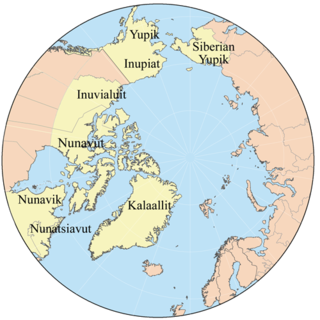
Eskimo is an exonym used to refer to two closely related Indigenous peoples: Inuit and the Yupik of eastern Siberia and Alaska. A related third group, the Aleut, which inhabit the Aleutian Islands, are generally excluded from the definition of Eskimo. The three groups share a relatively recent common ancestor, and speak related languages belonging to the Eskaleut language family.
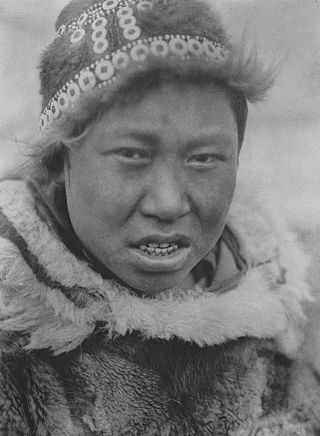
The Yupik are a group of Indigenous or Aboriginal peoples of western, southwestern, and southcentral Alaska and the Russian Far East. They are related to the Inuit and Iñupiat. Yupik peoples include the following:
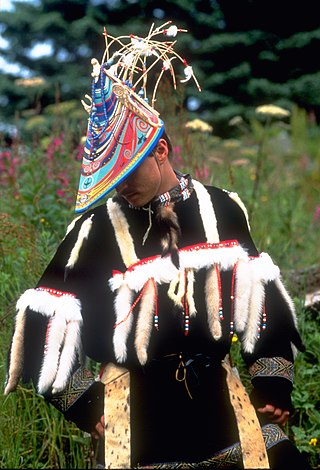
The Alutiiq people, also called by their ancestral name Sugpiaq, as well as Pacific Eskimo or Pacific Yupik, are one of eight groups of Alaska Natives that inhabit the southern-central coast of the region.

The history of Alaska dates back to the Upper Paleolithic period, when foraging groups crossed the Bering land bridge into what is now western Alaska. At the time of European contact by the Russian explorers, the area was populated by Alaska Native groups. The name "Alaska" derives from the Aleut word Alaxsxaq, meaning "mainland".
Claire Specht Fejes was an American artist.

Ramy "Ray" Brooks is an Alaska Native kennel owner and operator, motivational speaker, and dog musher who specializes in long-distance races. He is a two-time runner up in the 1,049+ mi Iditarod Trail Sled Dog Race across the U.S. state of Alaska, and a former winner of the 1,000 mi (1,600 km) Yukon Quest dog sled race across both Canada and the U.S.
Dorothy Jean Ray was an author and anthropologist best known for her study of Native Alaskan art and culture.
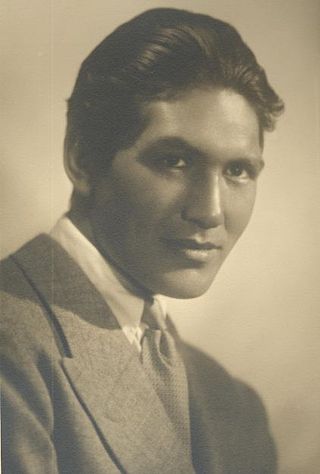
Ray Mala was a prominent Native American Hollywood actor. He was one of Hollywood's Native American movie actors along with Lillian St. Cyr, Jesse Cornplanter, Chief Yowlachie, William Eagle Shirt, and Will Rogers who also had successful careers during that time. Mala's career peaked in the 1930s and he was best known for his lead role in Republic Pictures' 14-part serial Robinson Crusoe of Clipper Island (1936) following his feature role in MGM's Eskimo, directed by Woody Van Dyke. He was named a "Top Ten Alaskan" by TIME Magazine in 2009.
Ann Fienup-Riordan is an American cultural anthropologist known for her work with the Yup'ik of western Alaska, particularly on Nelson Island and the Yukon–Kuskokwim Delta. She lives in Anchorage, Alaska. She received Historian of the Year awards from the Alaska Historical Society in 1991 and 2001.
Joan Arend Kickbush was a popular Alaskan artist. Her paintings and illustrations featured Alaska Native children, Yupik villagers and Arctic wildlife. She painted in watercolor and oil.

The Yup'ik or Yupiaq and Yupiit or Yupiat (pl), also Central Alaskan Yup'ik, Central Yup'ik, Alaskan Yup'ik, are an Indigenous people of western and southwestern Alaska ranging from southern Norton Sound southwards along the coast of the Bering Sea on the Yukon-Kuskokwim Delta and along the northern coast of Bristol Bay as far east as Nushagak Bay and the northern Alaska Peninsula at Naknek River and Egegik Bay. They are also known as Cup'ik by the Chevak Cup'ik dialect-speaking people of Chevak and Cup'ig for the Nunivak Cup'ig dialect-speaking people of Nunivak Island.
Velma May Wallis is a Native American writer of Gwich'in Athabascan Indian descent. Her books have been translated into 17 languages.

Ann Fox Chandonnet, born Ann Alicia Fox, is an American poet, journalist, book reviewer, and culinary historian.
The Tundra Times was a bi-weekly newspaper published in Fairbanks, Alaska from 1962 to 1997.

An Eskimo yo-yo or Alaska yo-yo is a traditional two-balled skill toy played and performed by the Eskimo-speaking Alaska Natives, such as Inupiat, Siberian Yupik, and Yup'ik. It resembles fur-covered bolas and yo-yo. It is regarded as one of the most simple, yet most complex, cultural artifacts/toys in the world. The Eskimo yo-yo involves simultaneously swinging two sealskin balls suspended on caribou sinew strings in opposite directions with one hand. It is popular with Alaskans and tourists alike. This traditional toy is two unequal lengths of twine, joined together, with hand-made leather objects at the ends of the twine.
Marie (Nick) Arnaq Meade is a Yup'ik professor in the humanities and also a Yup'ik tradition bearer. Meade's Yup'ik name is Arnaq which means "woman." She also works and travels with the International Council of Thirteen Indigenous Grandmothers. Meade is also part of the Nunamta Yup'ik Dance Group. Meade has been documenting the cultural knowledge of Yup'ik elders, including the values, language and beliefs of the Yup'ik people for over twenty years. She is currently an instructor at the University of Alaska Anchorage.

Mary Jane Fate was a Koyukon Athabascan activist. She was a founding member of the Fairbanks Native Association and the Institute of Alaska Native Arts and worked as a lobbyist for the Alaska Native Claims Settlement Act. She co-founded the Tundra Times newspaper and served as a director of the corporate board for Alaska Airlines for over two decades. She served as co-chair of the Alaska Federation of Natives between 1988 and 1989, the first woman to serve in the capacity, and was the third president and a founding member of the North American Indian Women's Association. Fate has served on various commissions and national studies of issues which affect indigenous people. She was the project manager of a study of women and disability, served as the only indigenous member of the U.S. Arctic Research Commission and was a member of U.S. Census Advisory Committee on indigenous populations. She has received numerous honors and awards for her activism on behalf of Native Americans and was inducted into the Alaska Women's Hall of Fame in 2014.
Beverly Patkotak Grinage is an American academic administrator and community organizer. She was president of Iḷisaġvik College from 2005 to 2010. Grinage is a former executive director of the Alaska Eskimo Whaling Commission and she was a public information officer for the North Slope Borough School District. Grinage has worked as campaign manager and previously was the owner of a publishing business. She was the managing editor of the Tundra Times and a member of the Alaska State Council on the Arts.

Hannah Paul Solomon was an American community leader and artist. She was the first female mayor of Fort Yukon, Alaska, helped organize the Fairbanks Native Association, and was inducted into the Alaska Women's Hall of Fame in 2012. Her traditional beadwork is in the collections of several museums.
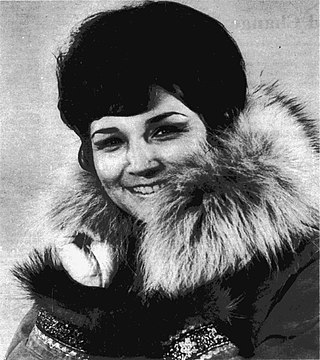
Laura Mae Bergt was an Iñupiaq athlete, model, politician, and activist for the Iñupiat and other Indigenous Alaskans. Born in the Northwest Arctic Borough of Alaska to bi-racial parents, she grew up in Nome and Kotzebue before attending high school in Sitka. Involved in the Native Olympic movement, she was both a nine-times winner of the Arctic Circle blanket toss event and served as chair of the World Eskimo Indian Olympics in 1966. She worked as a promoter for the new state of Alaska attending trade shows and making marketing appearances as a spokeswoman and guest on radio and television programs. From the 1960s, she worked in various policy positions at the tribal, local, state, and national level to address issues like disability, education, employment opportunities, housing, and poverty, and promoting the rights of Indigenous people.












